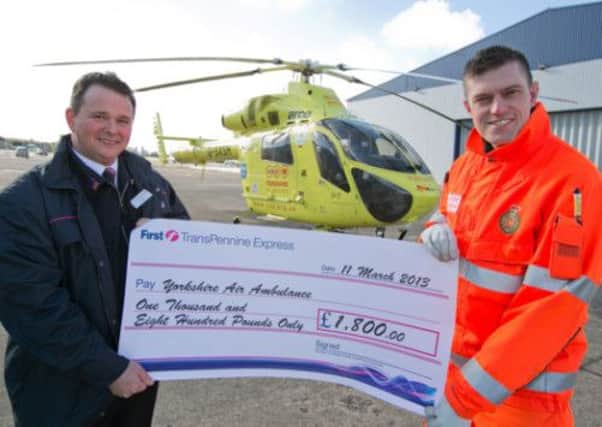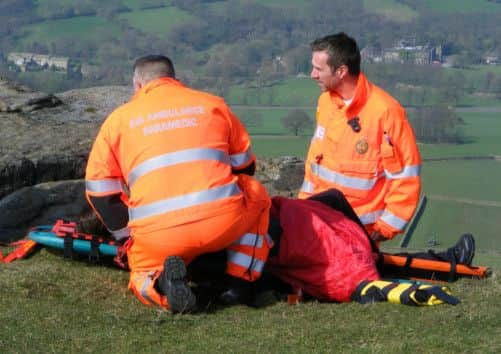Saving lives when every second counts


IT was September 17, 2012, and 51-year-old train driver David Graham had just brought the Transpennine Express Liverpool Lime Street to Scarborough service in on time at 9.20am. Within half an hour it was away again back to Merseyside.
David was feeling fine, despite having left his home in Liverpool to start a shift at 5.20am. After the train’s first stop at Seamer, David raised his right arm as usual to wave to the member of staff in a signal box nearby. As he put his arm down he noticed a pain in his chest.
Advertisement
Hide AdAdvertisement
Hide Ad“The pain quickly spread to my fingers and then up to my jaw,” says David, who had smoked 30-40 cigarettes a day for decades. “It became excruciating, and then came the dizziness, sweating and seeing double. I knew they were all the signs of a heart attack.”


David tried to stay conscious, so that he could safely get the train to Malton and seek help. But he collapsed, his head hitting the horn. As he lay there, swimming in and out of consciousness, with his left hand he managed use the radio to call the train guard. Alarms went off and the train slowly came to a halt.
Hilary Upson, an intensive care nurse from Scarborough, was travelling in the coach behind the driver’s cabin. She was only yards from David and saw him slump over the controls.
“I noticed his head go down, alarms I’d never heard went off and the train stopped just near Heslerton. The guard came and asked if there was a first-aider among the passengers. With another nurse who was part of a hen party, I got into the cab and tried to keep David calm and reassure him until an ambulance arrived. He was semi-conscious and vomiting. Someone passed us their angina spray to try. I felt helpless, really.”
Advertisement
Hide AdAdvertisement
Hide AdA regular ambulance came but it was decided that David needed to reach hospital as quickly as possible, so Yorkshire Air Ambulance were called. Once he was on board, it took minutes to ferry him to Castle Hill Hospital in Hull.
After his initial treatment, David was allowed to go home, attending rehabilitation sessions at a hospital nearby. He no longer smokes, has lost a couple of stone, and has been back at work since January. He feels the speedy journey to Hull with the air ambulance had a lot to do with this positive outcome.
“The work the air ambulance do is fantastic. They were so efficient. I was lucky enough to be looked after by skilled nurses on the train, then the helicopter and paramedics on board saved so much time in getting me to hospital. Between them, they’ve given me a second chance at life.”
At the end of June a charity event will be held in Liverpool with the aim of raising £5k for YAA, which is entirely self-funding.
Advertisement
Hide AdAdvertisement
Hide Ad“It’s my way of saying thanks,” says David. “I was told in Hull that if I’d gone by road to hospital I probably wouldn’t have made it.”
When 19-year-old Nic Kane set out from home at Sand Hutton in North Yorkshire with his brother Matthew and Dad Peter for a Sunday morning motorbike ride on July 1 last year, he could not have foreseen that within a couple of hours he, too, would be flown at high speed to hospital.
After a car crossed into the wrong lane and hit Nic head-on he was thrown to the ground and came back to to consciousness face down, unable to move at all. He knew his spine had been injured.
In view of the suspected severity of his condition, YAA were called in to get him quickly to James Cooke Hospital. He underwent a 15-hour operation, and his family lived through a touch-and-go situation for a couple of weeks.
Advertisement
Hide AdAdvertisement
Hide AdAlmost a year on, he is paralysed from the armpits downwards. He can use his arms and hands although he has no sensation in his fingers. The former mechanic who used to compete at motocross is confined to a wheelchair and says: “I’m still the same person, just sitting down.”
He plays wheelchair rugby with Sedgefield Bulls and faces life with the same cheerfulness and determination as ever, says his mum, Tricia. Friends have raised £10,000 for a customised off-road buggy so that he can explore the countryside independently with his dog and watch his beloved motocross
“If it wasn’t for the Air Ambulance I wouldn’t be here today,” says Nic. “I was told I wouldn’t have survived the trip in an ordinary ambulance because of the time it would have taken and the bumpiness of the road.
“I had no idea what a difference having help the help of the helicopter could make until I needed it myself.”
Advertisement
Hide AdAdvertisement
Hide AdYorkshire Air Ambulance Chairman Peter Sunderland said: “The charity is extremely aware that we would not be able to fund the running of the YAA without the help and support we receive from the people of Yorkshire.
“Everyday we are overwhelmed by the amazing support that is shown towards the charity, from donations and fundraising events to touching stories of how we have rescued friends and family members.
“We are unable to convey just how grateful we are to all those people who support us. We are confident that we will be able to meet the new increased daily running cost and with the support of the people of Yorkshire, will continue to provide a state of the art, rapid response emergency service 365 days a year across the region.”
Nic and David’s stories, as well as that of 65-year-old Philip Welch from York, who fell head first into a river when a footbridge collapsed, are told in the current BBC mini-series of Helicopter Heroes, which continues today (Weds) and Friday at 9.15am.
£9,990 a day cost of air ambulance
Advertisement
Hide AdAdvertisement
Hide AdYorkshire Air Ambulance (YAA) is an independent charity providing a rapid response emergency service.
To meet increased costs and fund planned service improvements, YAA now needs to raise £9,990 a day. That’s equivalent to £3.6m each year – up £1m on the previous fund raising target.
Last year the YAA attended a total of 933 incidents, transporting 431 patients directly to hospital for treatment – up from 376 patients the previous year.
Since coming online in October 2000, nearly 5,000 patients have been carried by YAA aircraft.
Advertisement
Hide AdAdvertisement
Hide AdYAA helicopters are always only 10 minutes from the nearest hospital and 15 minutes from the most relevant treatment centre.
YAA currently operates two helicopters from bases at Leeds Bradford Airport and RAF Topcliffe, near Thirsk.
This summer the charity will relocate from Leeds to a new improved base at Nostell Priory near Wakefield. This will improve flying times to remote areas in West and South Yorkshire.